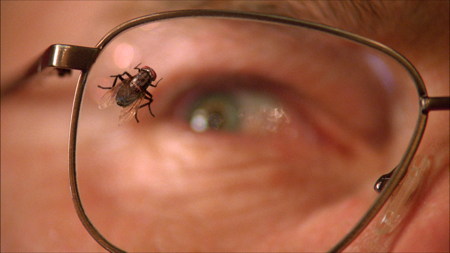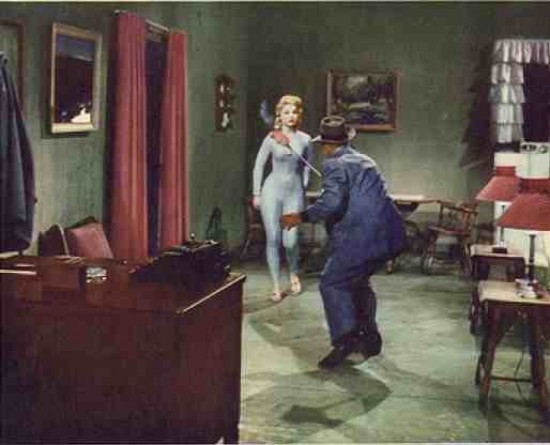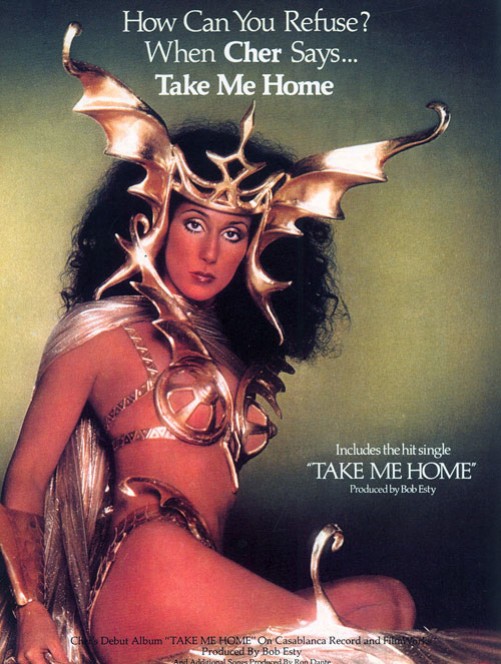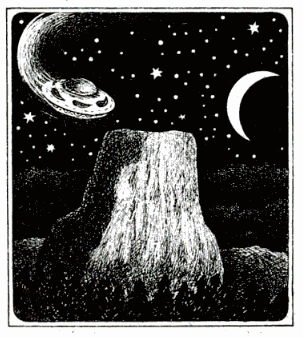Movies
Insect Art
If you've seen an insect in a movie, there's a good chance it was a prop made by insect artist Graham Owen. He specializes in the "design and fabrication of intricate life-size insect replicas" that are frequently used in movies and TV shows. His most famous insect might be the fly that tormented Walter White in an episode of Breaking Bad.A recent article about him offers more details about his art and career. And the article included this piece of info, which was new to me:

Posted By: Alex - Fri Sep 04, 2015 -
Comments (6)
Category: Art, Insects and Spiders, Movies
Auroratone
Auroratone was a "process for translating music into color" invented circa 1940 by Englishman Cecil Stokes. The music vibrated an emulsion of crystallizing chemicals, and this was then photographed by a color movie camera, producing a kind of psychedelic movie of shifting colors synchronized with music (but this was the 1940s, before the concept of psychedelics was known in popular culture).The hope was that these auroratone films could be used to treat psychiatric patients, and they were experimentally shown to soldiers in an army hospital suffering from psychotic depressions. Conclusion: "Observation revealed that these patients were intensely absorbed in the films, that their span of attention to the films was appreciably lengthened after exposure to the films. Weeping and sobbing was observed in some patients. Many patients became more accessible to individual and group psychotherapy immediately folllowing exposure to these films."
Their effect was also tested on juvenile delinquents. One kid told the experimenter, "I think God must have painted those pictures."
A company was formed to commercialize Auroratones and guide their development. Investors in this company included the Crosby Brothers (Larry and his famous brother Bing). Bing sang the music for many of the auroratones.
Treating psychiatric patients wasn't very profitable, so there was hope to find more lucrative applications of the auroratone process. One idea was to transfer auroratone color patterns onto textiles and ceramics. Some silk scarfs printed with visualizations of Bing Crosby singing "Home on the Range" were apparently manufactured, but never sold.
Not many auroratones still survive, but an example of one can be viewed on YouTube:
The auroratone process reminds me of the Clavilux (or Color Organ) invented by Thomas Wilfred in 1919 (previously posted about here).
More info about auroratones: Wikipedia and Milwaukee Journal, Dec 6, 1948.
Also see: Rubin, HE & Katz, E. (Oct 1946). "Auroratone films for the treatment of psychotic depressions in an army general hospital," Journal of Clinical Psychology, 2(4): 333-340.
Posted By: Alex - Thu Sep 03, 2015 -
Comments (9)
Category: Movies, Photography and Photographers, Psychology, 1940s
The Astounding She-Monster

Doesn't the narrator at the start of the full film sound like Troy McClure from THE SIMPSONS?
Posted By: Paul - Sat Jul 11, 2015 -
Comments (3)
Category: Aliens, Movies, Sex Symbols, 1950s
Follies of the Madmen #253

If only Hollywood had made John Carter of Mars in 1979, with Cher as Dejah Thoris, they would have had a surefire hit!
Posted By: Paul - Sun Jul 05, 2015 -
Comments (2)
Category: Fashion, Hollywood, Movies, Music, Advertising, Science Fiction, 1970s
The Nude Vampire
As you might expect from the title, this trailer contains a small amount of mild chestal exposure, more-or-less consistent with the tamest of HBO programs.
Posted By: Paul - Sun Jun 21, 2015 -
Comments (3)
Category: Ineptness, Crudity, Talentlessness, Kitsch, and Bad Art, Movies, Paranormal, 1970s
Incubus, the Esperanto Movie
According to wikipedia, there are only four full-length films shot entirely in Esperanto. One of these four is the 1966 black-and-white horror film Incubus, starring William Shatner.The film had an LA premiere, but then, partly because of the Esperanto dialogue, it never found a distributor except in France and fell into obscurity. For years it was believed that all copies of the film had disappeared, until the 1990s when a copy was found in France.
Here's the trailer:
And here's the full-length film:
Posted By: Alex - Tue Jun 16, 2015 -
Comments (7)
Category: Horror, Languages, Movies, 1960s
Film critic who got it wrong

In the Nov 7, 1977 issue of New York magazine, Bill Flanagan reviewed Close Encounters of the Third Kind. He hated it, and he was certain that everyone else was going to hate it too, predicting it would be "a colossal flop" and almost gleefully forecasting financial disaster for Columbia Pictures as a result, since they had bet heavily on the movie's success. He dismissed the fact that everyone else in the pre-screening he attended seemed to like it, noting, "When you give people free tickets to a movie, most of them are nice enough not to bitch."
Flanagan, of course, couldn't have been more wrong. As wikipedia notes:
Posted By: Alex - Wed Jun 10, 2015 -
Comments (7)
Category: Movies, 1970s
Monster on the Campus
Posted By: Paul - Fri Jun 05, 2015 -
Comments (2)
Category: Ineptness, Crudity, Talentlessness, Kitsch, and Bad Art, Movies, 1950s, Fictional Monsters
El Santo vs. la Invasion de los Marcianos
I regret that I cannot find English-language versions for you. But the visuals are everything.
Complete film below. Wikipedia page for Santo.
Posted By: Paul - Mon May 25, 2015 -
Comments (2)
Category: Aliens, Daredevils, Stuntpeople and Thrillseekers, Movies, Wrestling, Foreign Customs, Science Fiction, 1960s
Hippie Wisdom from Donald Sutherland and Rod McKuen
Mad Men is over. But you can still savor that era with lots of videos such as these two.
Is that the actress's real voice?
Posted By: Paul - Wed May 20, 2015 -
Comments (3)
Category: Bombast, Bloviation and Pretentiousness, Movies, Music, Bohemians, Beatniks, Hippies and Slackers, 1960s

| Who We Are |
|---|
| Alex Boese Alex is the creator and curator of the Museum of Hoaxes. He's also the author of various weird, non-fiction, science-themed books such as Elephants on Acid and Psychedelic Apes. Paul Di Filippo Paul has been paid to put weird ideas into fictional form for over thirty years, in his career as a noted science fiction writer. He has recently begun blogging on many curious topics with three fellow writers at The Inferior 4+1. Contact Us |




